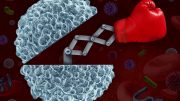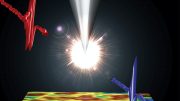
Researchers have gained new insight into the biological processes of a chytrid fungus responsible for a deadly skin infection devastating frog populations worldwide.
Bd’s actin structures likely play roles in causing skin disease threatening amphibians worldwide.
Researchers at the University of Massachusetts Amherst have gained new insight into the biological processes of a chytrid fungus responsible for a deadly skin infection devastating frog populations worldwide.
Led by cell biologist Lillian Fritz-Laylin, the team describes in a paper published today (February 8, 2021) in Current Biology how the actin networks of Batrachochytrium dendrobatidis (Bd) also serve as an “evolutionary Rosetta Stone,” revealing the loss of cytoskeletal complexity in the fungal kingdom.

Research associate Sarah Prostak initially wrote what later became the Current Biology paper for her undergraduate honors biology thesis at the University of Massachusetts Amherst. Credit: UMass Amherst
“Fungi and animals seem so different, but they are actually pretty closely related,” says Fritz-Laylin, whose lab studies how cells move, which is a central activity in the progression and prevention of many human diseases. “This project, the work of Sarah Prostak in my lab, shows that during early fungal evolution, fungi probably had cells that looked something like our cells, and which could crawl around like our cells do.”
Chytrids including Bd encompass more than 1,000 species of fungi deep on the phylogenetic, or evolutionary, tree. The researchers used chytrids, which share features of animal cells that have been lost in yeast and other fungi, to explore the evolution of actin cytoskeleton, which helps cells keep their shape and organization and carry out movement, division and other crucial functions.
Prostak, a research associate in Fritz-Laylin’s lab, is the lead author of the paper, which she initially wrote as her undergraduate honors biology thesis, the expanded and finished the research after graduation. Other authors are Margaret Titus, professor of genetics, cell biology and development at the University of Minnesota, and Kristyn Robinson, a UMass Amherst Ph.D. candidate in Fritz-Laylin’s lab.
“Bd is more closely related to animal cells than more typically studied fungi so it can tell us a lot about the animal lineage and the fungal lineage and can also provide a lot of insight into human actin networks,” Prostak says. “We can use it to study animal-like regulation in a similar system rather than actually studying it in animal cells, which is very complicated because animal cells have so many actin regulators.”

Lillian Fritz-Laylin is a professor of biology in the College of Natural Sciences at the University of Massachusetts Amherst. Credit: UMass Amherst
The research team used a combination of genomics and fluorescence microscopy to show that chytrids’ actin cytoskeleton has features of both animal cells and yeast. “How these complex actin regulatory networks evolved and diversified remain key questions in both evolutionary and cell biology,” the paper states.
The biologists explored the two developmental stages in Bd’s life cycle. In the first stage, Bd zoospores swim with a flagellum and build actin structures similar to those of animal cells, including pseudopods that propel the organisms forward. In the reproductive stage, Bd sporangia assemble actin shells, as well as actin patches, which are similar to those of yeast.
The disease chytridiomycosis, caused by Bd, ravages the skin of frogs, toads and other amphibians, eventually leading to heart failure after throwing off fluid regulation. This disease has been attributed to huge losses of biodiversity, including dozens of presumed population declines and extinctions over the past 50 years, though exactly how many species have been affected by this disease has been subject to debate.
The UMass Amherst biologists say Bd’s actin structures they observed likely play important roles in causing the disease. “This model suggests that actin networks underlie the motility and rapid growth that are key to the pathology and pathogenicity of Bd,” the paper concludes.
Prostak, an animal lover drawn to Fritz-Laylin’s lab because of its focus on pathogens, hopes their research advancing the knowledge about Bd will lead to measures that slow the deadly damage of chytridiomycosis.
“Figuring out the basic biology of Bd will hopefully give insight into disease mitigation in the future,” Prostak says.
Reference: “The actin networks of chytrid fungi reveal evolutionary loss of cytoskeletal complexity in the fungal kingdom” by Sarah M. Prostak, Kristyn A. Robinson, Margaret A. Titus and Lillian K. Fritz-Laylin, 8 February 2021, Current Biology.
DOI: 10.1016/j.cub.2021.01.001
Funding: Pew Charitable Trust, National Institutes of Health









Babu G. Ranganathan*
(B.A. Bible/Biology)
THE NATURAL LIMITS TO EVOLUTION
ONLY LIMITED EVOLUTION (micro-evolution or evolution within biological “kinds”) is genetically possible (such as the varieties of dogs, cats, horses, cows, etc.), but not macro-evolution, or evolution across biological “kinds,” (such as from sea sponge to human). All real evolution in nature is simply the expression, over time, of already existing genes or variations of already existing genes. For example, we have breeds of dogs today that we didn’t have a few hundred years ago. The genes for these breeds had always existed in the dog population but never had opportunity before to be expressed. Only limited evolution, variations of already existing genes and traits, is possible.
The genes (chemical instructions or code) for a trait must first exist or otherwise the trait cannot come into existence. Genes instruct the body to build our tissues and organs. Nature is mindless and has no ability to design and program entirely new genes for entirely new traits.
Evolutionists believe that, if given millions of years, accidents in the genetic code of species caused by the environment will generate entirely new code making evolution possible from one type of life to another. It’s much like believing that by randomly changing the sequence of letters in a romance novel, over millions of years, can turn the novel into a book on astronomy! Not to worry. We’ll address the issue of “Junk DNA” in a moment.
WHAT ABOUT NATURAL SELECTION? Natural selection doesn’t produce biological traits or variations. It can only “select” from biological variations that are possible and which have survival value.
HOW COULD SPECIES HAVE SURVIVED if their vital tissues, organs, reproductive systems, etc. were still evolving? A partially evolved trait or organ that is not complete and fully integrated and functioning from the start would be a liability to a species, not a survival asset. Plants and animals in the process of macro-evolution would be unfit for survival. For example, “if a leg of a reptile were to evolve (over supposedly millions of years) into a wing of a bird, it would become a bad leg long before it became a good wing” (Dr. Walt Brown, scientist and creationist). Survival of the fittest actually would have prevented evolution across biological kinds!
NEW SPECIES BUT NOT NEW DNA: Although it’s been observed that new species have come into existence, they don’t carry any new genes. They’ve become new species only because they can’t be crossed back with the original parent stock for various biological reasons. A biological “kind” allows for new species but not new genes. Nature has no ability to invent new genes for new traits. Only limited variations and adaptations are possible in nature, and all strictly within a biological “kind” (i.e. varieties of dogs, cats, etc.).
Dr. Randy J. Guliuzza’s extensive research points to a better explanation than natural selection for variation and adaptation in nature. Dr. Guliuzza explains that species have pre-engineered mechanisms that enable organisms to continuously track and respond to environmental changes with system elements that correspond to human-designed tracking systems. This model is called CET (continuous environmental tracking). His research strongly indicates that living things have been pre-engineered to produce the right adaptations and changes required to live in changing environments. It’s much like a car that’s been pre-engineered so that the head lights turn on automatically when day changes to night.
What about genetic and biological similarities between species? Genetic information, like other forms of information, cannot happen by chance, so it is more logical to believe that genetic and biological similarities between all forms of life are due to a common Designer who designed similar functions for similar purposes. It doesn’t mean all forms of life are biologically related! Only genetic similarities within a natural species proves relationship because it’s only within a natural species that members can interbreed and reproduce.
Many people have wrong ideas of how evolution is supposed to work. Physical traits and characteristics are determined and passed on by genes – not by what happens to our body parts. For example, if a woman were to lose her finger this wouldn’t affect how many fingers her baby will have. Changing the color and texture of your hair will not affect the color and texture of your children’s hair. So, even if an ape or ape-like creature’s muscles and bones changed so that it could walk upright it still would not be able to pass on this trait to its offspring. Only changes or mutations that occur in the genetic code of reproductive cells (i.e. sperm and egg) can be passed on to offspring.
What about the new science of epigenetics? Epigenetics involves inheritable factors which can turn already-existing genes on, but epigenetics doesn’t create new genes.
Most biological variations are from new combinations of already existing genes, not mutations. Mutations are accidents in the genetic code caused by nature (i.e. environmental radiation), are mostly harmful, and have no capability of producing greater complexity in the code. Even if a good accident occurred, for every good one there would be hundreds of harmful ones with the net result, over time, being harmful, even lethal, to the species. Even if a single mutation is not immediately harmful, the accumulation of mutations over time will be harmful to the species resulting in extinction. At very best, mutations only produce further variations within a natural species.
All species of plants and animals in the fossil record are found complete, fully formed, and fully functional. This is powerful evidence that all species came into existence as complete and fully formed from the beginning. This is only possible by creation.
God began with a perfect and harmonious creation. Even all the animals were vegetarian (Genesis 1:30) in the beginning and did not struggle for survival nor kill and devour each other. Macro-evolutionary theory does not begin with a perfect and harmonious creation as the Bible states. The Bible and macro-evolutionary theory cannot both be true.
All the fossils that have been used to support human evolution have been found to be either hoaxes, non-human, or human, but not non-human and human (i.e. Neanderthal Man was discovered later to be fully human).
There has never been unanimous agreement among evolutionary scientists on ANY fossil evidence that has been used to support human evolution over the many years, Including LUCY.
The actual similarity between ape and human DNA is between 70-87% not 99.8% as commonly believed. The original research stating 99.8% similarity was based on ignoring contradicting evidence. Only a certain segment of DNA between apes and humans was compared, not the entire DNA genome.
Also, so-called “Junk DNA” isn’t junk. Although these “non-coding” segments of DNA don’t code for proteins, they have recently been found to be vital in regulating gene expression (i.e. when, where, and how genes are expressed, so they’re not “junk”). Also, there is evidence that, in certain situations, they can code for protein.
ARE FOSSILS REALLY MILLIONS OF YEARS OLD? (Internet article by author)
Visit my latest Internet site: THE SCIENCE SUPPORTING CREATION (This site answers many arguments, both old and new, that have been used by evolutionists to support their theory)
Author of popular Internet article, TRADITIONAL DOCTRINE OF HELL EVOLVED FROM GREEK ROOTS
*I have given successful lectures (with question and answer period afterwards) defending creation before evolutionist science faculty and students at various colleges and universities. I’ve been privileged to be recognized in the 24th edition of Marquis “Who’s Who in The East” for my writings on religion and science.